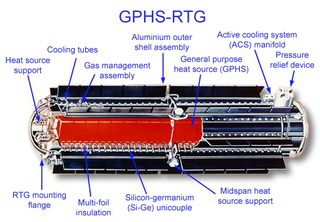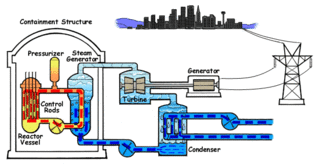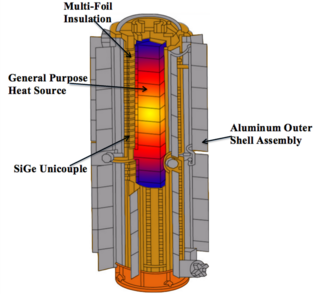
Spacecraft propulsion is any method used to accelerate spacecraft and artificial satellites. In-space propulsion exclusively deals with propulsion systems used in the vacuum of space and should not be confused with space launch or atmospheric entry.

A magnetoplasmadynamic (MPD) thruster (MPDT) is a form of electrically powered spacecraft propulsion which uses the Lorentz force to generate thrust. It is sometimes referred to as Lorentz Force Accelerator (LFA) or MPD arcjet.

A nuclear thermal rocket (NTR) is a type of thermal rocket where the heat from a nuclear reaction replaces the chemical energy of the propellants in a chemical rocket. In an NTR, a working fluid, usually liquid hydrogen, is heated to a high temperature in a nuclear reactor and then expands through a rocket nozzle to create thrust. The external nuclear heat source theoretically allows a higher effective exhaust velocity and is expected to double or triple payload capacity compared to chemical propellants that store energy internally.
A nuclear electric rocket is a type of spacecraft propulsion system where thermal energy from a nuclear reactor is converted to electrical energy, which is used to drive an ion thruster or other electrical spacecraft propulsion technology. The nuclear electric rocket terminology is slightly inconsistent, as technically the "rocket" part of the propulsion system is non-nuclear and could also be driven by solar panels. This is in contrast with a nuclear thermal rocket, which directly uses reactor heat to add energy to a working fluid, which is then expelled out of a rocket nozzle.
In a traditional nuclear photonic rocket, an onboard nuclear reactor would generate such high temperatures that the blackbody radiation from the reactor would provide significant thrust. The disadvantage is that it takes much power to generate a small amount of thrust this way, so acceleration is very low. The photon radiators would most likely be constructed using graphite or tungsten. Photonic rockets are technologically feasible, but rather impractical with current technology based on an onboard nuclear power source.

A radioisotope thermoelectric generator, sometimes referred to as a radioisotope power system (RPS), is a type of nuclear battery that uses an array of thermocouples to convert the heat released by the decay of a suitable radioactive material into electricity by the Seebeck effect. This type of generator has no moving parts and is ideal for deployment in remote and harsh environments for extended periods with no risk of parts wearing out or malfunctioning.
A propellant is a mass that is expelled or expanded in such a way as to create a thrust or another motive force in accordance with Newton's third law of motion, and "propel" a vehicle, projectile, or fluid payload. In vehicles, the engine that expels the propellant is called a reaction engine. Although technically a propellant is the reaction mass used to create thrust, the term "propellant" is often used to describe a substance which contains both the reaction mass and the fuel that holds the energy used to accelerate the reaction mass. For example, the term "propellant" is often used in chemical rocket design to describe a combined fuel/propellant, although the propellants should not be confused with the fuel that is used by an engine to produce the energy that expels the propellant. Even though the byproducts of substances used as fuel are also often used as a reaction mass to create the thrust, such as with a chemical rocket engine, propellant and fuel are two distinct concepts.
A solar thermal rocket is a theoretical spacecraft propulsion system that would make use of solar power to directly heat reaction mass, and therefore would not require an electrical generator, like most other forms of solar-powered propulsion do. The rocket would only have to carry the means of capturing solar energy, such as concentrators and mirrors. The heated propellant would be fed through a conventional rocket nozzle to produce thrust. Its engine thrust would be directly related to the surface area of the solar collector and to the local intensity of the solar radiation.

Nuclear propulsion includes a wide variety of propulsion methods that use some form of nuclear reaction as their primary power source. The idea of using nuclear material for propulsion dates back to the beginning of the 20th century. In 1903 it was hypothesized that radioactive material, radium, might be a suitable fuel for engines to propel cars, planes, and boats. H. G. Wells picked up this idea in his 1914 fiction work The World Set Free. Many aircraft carriers and submarines currently use uranium fueled nuclear reactors that can provide propulsion for long periods without refueling. There are also applications in the space sector with nuclear thermal and nuclear electric engines which could be more efficient than conventional rocket engines.

Laser propulsion is a form of beam-powered propulsion where the energy source is a remote laser system and separate from the reaction mass. This form of propulsion differs from a conventional chemical rocket where both energy and reaction mass come from the solid or liquid propellants carried on board the vehicle.

Project Prometheus was established in 2003 by NASA to develop nuclear-powered systems for long-duration space missions. This was NASA's first serious foray into nuclear spacecraft propulsion since the cancellation of the SNTP project in 1995. The project was planned to design, develop, and fly multiple deep space missions to the outer planets.

A radioisotope heater unit (RHU) is a small device that provides heat through radioactive decay. They are similar to tiny radioisotope thermoelectric generators (RTG) and normally provide about one watt of heat each, derived from the decay of a few grams of plutonium-238—although other radioactive isotopes could be used. The heat produced by these RHUs is given off continuously for several decades and, theoretically, for up to a century or more.
An atomic battery, nuclear battery, radioisotope battery or radioisotope generator uses energy from the decay of a radioactive isotope to generate electricity. Like a nuclear reactor, it generates electricity from nuclear energy, but it differs by not using a chain reaction. Although commonly called batteries, atomic batteries are technically not electrochemical and cannot be charged or recharged. Although they are very costly, they have extremely long lives and high energy density, so they are typically used as power sources for equipment that must operate unattended for long periods, such as spacecraft, pacemakers, underwater systems, and automated scientific stations in remote parts of the world.

Spacecraft electric propulsion is a type of spacecraft propulsion technique that uses electrostatic or electromagnetic fields to accelerate mass to high speed and thus generating thrust to modify the velocity of a spacecraft in orbit. The propulsion system is controlled by power electronics.

GPHS-RTG or general-purpose heat source — radioisotope thermoelectric generator, is a specific design of the radioisotope thermoelectric generator (RTG) used on US space missions. The GPHS-RTG was used on Ulysses (1), Galileo (2), Cassini-Huygens (3), and New Horizons (1).

The multi-mission radioisotope thermoelectric generator (MMRTG) is a type of radioisotope thermoelectric generator (RTG) developed for NASA space missions such as the Mars Science Laboratory (MSL), under the jurisdiction of the United States Department of Energy's Office of Space and Defense Power Systems within the Office of Nuclear Energy. The MMRTG was developed by an industry team of Aerojet Rocketdyne and Teledyne Energy Systems.
A thermal rocket is a rocket engine that uses a propellant that is externally heated before being passed through a nozzle to produce thrust, as opposed to being internally heated by a redox (combustion) reaction as in a chemical rocket.

Nuclear power in space is the use of nuclear power in outer space, typically either small fission systems or radioactive decay for electricity or heat. Another use is for scientific observation, as in a Mössbauer spectrometer. The most common type is a radioisotope thermoelectric generator, which has been used on many space probes and on crewed lunar missions. Small fission reactors for Earth observation satellites, such as the TOPAZ nuclear reactor, have also been flown. A radioisotope heater unit is powered by radioactive decay and can keep components from becoming too cold to function, potentially over a span of decades.

The Multihundred-watt radioisotope thermoelectric generator is a type of US radioisotope thermoelectric generator (RTG) developed for the Voyager spacecraft, Voyager 1 and Voyager 2. The Voyager generators continue to function more than 45 years into the mission.

Silicon-germanium (SiGe) thermoelectrics have been used for converting heat into electrical power in spacecraft designed for deep-space NASA missions since 1976. This material is used in the radioisotope thermoelectric generators (RTGs) that power Voyager 1, Voyager 2, Galileo, Ulysses, Cassini, and New Horizons spacecraft. SiGe thermoelectric material converts enough radiated heat into electrical power to fully meet the power demands of each spacecraft. The properties of the material and the remaining components of the RTG contribute towards the efficiency of this thermoelectric conversion.












